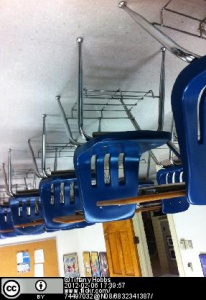‘Flipped Classroom‘ is a term that refers to the restructuring of teaching in order to maximise the benefit of contact time between students and tutors. In a ‘flipped classroom’ the’ homework’ and ‘lecture’ elements of a traditional teaching approach are reversed, with the students engaging with the required information as pre-work so that the contact time can focus on exploring their new knowledge, answering questions about the information and clarifying any misunderstandings that may have arisen.
How it Works

“Q Reads” by Queen’s University
A flipped classroom places special emphasis on the social aspect of learning, by moving the informational aspect to be a pre-sessional activity and making the face-to-face sessions a way of checking understanding and building new knowledge through interaction with peers and tutors. The exact way this occurs depends on the type of information that the students need to understand. For example, in some situations the students may be directed to read a book chapter or paper and the in-class session will be devoted to a discussion of the implications evident in the reading, whereas in another situation the students may be required to watch a series of videos demonstrating a particular technique and practice on their own, with each student performing the technique in-class and receiving feedback from peers and tutors.This shows that the Flipped Classroom concept is highly adaptable to different situations and disciplines. In essence, it is a way of making space within the timetable to use more engaging methods of learning and teaching. While the approach has been widely used for many years, particularly in the humanities, technology is now making it increasingly achievable in other disciplines too.
Possible Technologies to Support the Approach
The Flipped Classroom approach is not dependent on using technology, as the pre-work could be to read a chapter from a book or a journal article, visit a museum or gallery, watch a video, etc. However, several tools exist that can be used to support the pre-work element of a Flipped Classroom.
One of the main types of tool used for Flipped Classroom approaches is screencasting software. This software allows the creation of videos that show the contents of a computer screen accompanied by a narrated audio track, which can be uploaded to YouTube or Blackboard for the students to watch. While this type of software is particularly suited to demonstrating software or computer-based processes, it can also be used to record and narrate Powerpoint-type presentations. Common tools used to create screencasts include Camtasia, Jing, and the free online tool, Screencast-o-matic. It is also possible to record your narration directly into Powerpoint and have the relevant audio play automatically as a viewer moves through the slides. The Blackboard Collaborate virtual classroom tool can also be used to record presentations for students to watch at a later date and so is another useful tool for a flipped classroom
Online quizzes and tests are also useful in a flipped classroom because they allow students to check their understanding of the materials, and so come to the face-to-face session with an awareness of their misunderstandings or where they require further information. The results of the quiz can also assist tutors in identifying topics where a significant proportion of the students are having problems and so adjust the face-to-face session to specifically address those areas, and the responses help tutors identify students that are, or are not, engaging with the materials. The Test tool in Blackboard is ideal for use in the flipped classroom because it has useful features such as selecting questions randomly from a set and producing reports of the entire cohort’s, and individual students’, responses to the questions.
The Resource Lists Online tool is a good way to make sure that information about readings and online resources, such as videos, is readily available to students. The information can be linked to the relevant area in Blackboard and additional resources can easily be added by tutors on the module site.
Getting Started
If you are interested in trying out a Flipped Classroom there are a few practical questions that you should answer:
- Where in the course/module would this approach work best? When is there a large amount of information delivered in face-to-face sessions where the time could be better spent on other activities?
- What would be the best way to deliver this information to students?
- What activities would be done in class to support the students’ pre-work?
- How will students who haven’t done the pre-work take part in the session activities? Will this be monitored in advance of the session?
- How much technology should be involved? Which tools are most suited? What support would be needed?
- Are the students (and other tutors) ready for this?
Having thought about these questions, you should have worked out whether Flipped Classroom is an approach that makes sense in your context and have some ideas about how to introduce it. If you are still unsure, you could try ‘flipping’ a single lecture or seminar and see how the students respond.
Further Resources
The following links are to case studies showing how staff at SHU have used Flipped Classroom ideas in their teaching:
- Illustrating difficult concepts using screencasts – Cecile Morris
Related ‘Teaching Nuggets’:
The following links provide further information on some activities and assessment outputs that can work well with Flipped Classroom tasks, especially for students who are part-time or not campus-based:
Other resources:
- Flipping the classroom – Cynthia J. Brame
- 7 things you should know about Flipped Classrooms – Educause
- Little Guide to Screencasting – JISC
- ‘Menu’ of Teaching Approaches – Sheffield Hallam University




Pingback: Online screencasting software available for SHU staff | Technology Enhanced Learning at SHU